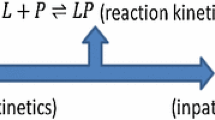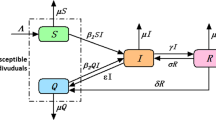Abstract
Drug dependence is a ‘chronic disease’ treatable through rehabilitation. Many drug addicts progress through a series of rehabilitation and relapsing episodes. In this paper, we formulate a mathematical model with n-alternate stages of rehabilitation and relapsing. The dynamics of drug abuse are treated as an infectious disease that spreads through a population. The model analysis shows that the model has two equilibria, the drug free equilibrium and the drug persistent equilibrium, that are both globally stable when the threshold \({\mathcal {R}}_{0}<1\) and \({\mathcal {R}}_{0}>1\) respectively. The model is fitted to data on individuals under repeated rehabilitation and parameter values that give the best fit chosen. The projections carried out the long term trends of proportions for repeated rehabilitants. The relative impact for each subgroup is determined to find out which population subgroup is responsible for a disproportionate number of initiations. The results have huge implications to designing policies aligned to rehabilitation processes.






Similar content being viewed by others
References
United Nations Office on Drugs and Crime (WHO) (2009).https://www.unodc.org/documents/wdr/WDR_2009/WDR2009_eng_web.pdf.Accessed 26 May 2014
Powledge, T.M.: Addiction and the brain: the dopamine pathway is helping researchers find their way through the addiction maze (1999). http://bioscience.oxfordjournals.org. Accessed 15 June 2014
Buonomo, B., Lacitignola, D.: Modeling peer influence effects on the spread of high-risk alcohol consumption behavior. Ric. Mat. 63(1), 101–117 (2014)
Benedict, B.: Modeling alcoholism as a contagious disease: how infected drinking buddies spread problem drinking. SIAM News 40(3) (2007)
Walters, C.E., Straughan, B., Kendal, J.R.: Modelling alcohol problems: total recovery. Ric. Mat. 62, 33–53 (2013)
Bissell, J.J., Caiado, C.C.S., Goldstein, M., Straughan, B.: Compartmental modelling of social dynamics with generalised peer incidence. Math. Models Methods Appl. Sci. 24(04), 719–750 (2014)
Njagarah, J.B.H., Nyabadza, F.: Modelling the impact of rehabilitation, amelioration and relapse on the prevalence of drug epidemics. J. Biol. Syst. 21 (2013)
Nyabadza, F., Hove-Musekwa, S.D.: From heroin epidemics to methamphetamine epidemics: modelling substance abuse in a South African province. Math. Biosci. 225, 132–140 (2010)
Nyabadza, F., Njagarah, J.B.H., Smith, R.J.: Modelling the dynamics of crystal meth (Tik) abuse in the presence of drug-supply chains in South Africa. Bull. Math. Biol. (2012). doi:10.1007/s11538-012-9790-5
Nyabadza, F., Hove-Musekwa, S.D.: Substance abuse in the Western Cape province of South Africa: insights through mathematical modelling. SACEMA Q. (2010). http://sacemaquarterly.com/mathematical-modelling/substance-abuse-in-the-western-cape-province-of-south-africa-insights-through-mathematical-modelling.html. Accessed 15 June 2014
Samanta, G.P.: Dynamic behaviour for a non-autonomous heroin epidemic model with time delay. J. Appl. Math. Comput. 35, 161–178 (2011)
White, E., Comiskey, C.: Heroin epidemics, treatment and ODE modelling. Math. Sci. 208, 312–324 (2007)
Buddy, T.: Warning signs of an alcohol or drug relapse. http://alcoholism.about.com/od/relapse/a/relapse_signs.htm. Accessed 15 June 2014
Herd, N., Borland, R., Hyland, A.: Predictors of smoking relapse by duration of abstinence: findings from the International Tobacco Control (ITC) Four Country Survey. Addiction 104, 2088–2099 (2009)
Hyman, J.M., Li, J., Stanley, E.A.: The differential infectivity and staged progression models for the transmission of HIV. Math. Biosci. 155, 77–109 (1999)
Hyman, J.M., Li, J.: An intuitive formulation for the reproduction number for the spread of disease in heterogeneous population. Math. Biosci. 167, 65–86 (2000)
Zhien, M., Jianping, L., Jia, L.: Stability analysis for differential infectivity epidemic models. Nonlinear Anal. Real World Appl. 4, 841–856 (2003)
Zhisheng, S., Driessche, P.: Global dynamics of cholera models with differential infectivity. Math. Biosci. 234, 118–126 (2011)
Wang, L., Jian-quan, L.: Global stability of an epidemic model with non-linear incidence rate and differential infectivity. Appl. Math. Comput. 161, 769–778 (2005)
Thieme, H.R., Castillo-Chavez, C.: How may infection-age dependent infectivity affect the dynamics of HIV/AIDS? SIAM J. Appl. Math. 53, 1447–1479 (1992)
Guo, H., Li, M.Y.: Global dynamics of a staged progression model for infectious diseases. Math. Biosci. Eng. 3, 513–525 (2006)
Simon, C.P., Jacquez, J.A.: Reproduction numbers and the stability of equilibria of SI models for heterogeneous populations. SIAM J. Appl. Math. 52, 541 (1992)
Driessche, P., Watmough, J.: Reproduction numbers and sub-threshold endemic equilibria for the compartmental models of disease transmission. Math. Biosci. 180, 29–48 (1999)
LaSalle, J.P.: The Stability of Dynamical Systems. Society for Industrial and Applied Mathematics, Philadelphia (1976)
Freedman, H.I., So, J.W.H.: Global stability and persistence of simple food chains. Math. Biosci. Eng. 76, 69–86 (1985)
Cruz, V.D.L.: On the global stability of infectious disease model with relapse. Abstr. Appl. 9, 50–61 (2013)
Korobinikov, A., Maini, P.K.: A Lyapunov function and some properties for SEIR, SIS epidemic models. Math. Biosci. Eng. 1, 157–160 (2004)
The South African Community Epidemiology Network on Drug Use (SACENDU). http://www.mrc.ac.za/adarg/sacendu.htm. Accessed 22 Sept 2014
Beating the Relapse statistics. http://alcoholrehab.com/addiction-recovery/beating-the-relapse-statistics/. Accessed 22 Sept 2014
Jamison, D.T., Feachmen, R.G., Makgoba, M.W., Bos, E.R., Baingana, F.K., Hofman, K.J., Rogo, K.O.: Disease and Mortality in Sub-Saharan Africa, 2nd edn. World Bank, Washington (2006)
Acknowledgments
Two of the authors acknowledge, with thanks, the support of the Department of Mathematics, University of Zimbabwe. F. Nyabadza acknowledges with gratitude the support from National Research Foundation and Stellenbosch University for the production of this manuscript.
Author information
Authors and Affiliations
Corresponding author
Additional information
Communicated by Salvatore Rionero.
This work was supported by the National Research Foundation (NRF).
Rights and permissions
About this article
Cite this article
Mushanyu, J., Nyabadza, F., Muchatibaya, G. et al. Modelling multiple relapses in drug epidemics. Ricerche mat. 65, 37–63 (2016). https://doi.org/10.1007/s11587-015-0241-0
Received:
Revised:
Published:
Issue Date:
DOI: https://doi.org/10.1007/s11587-015-0241-0




